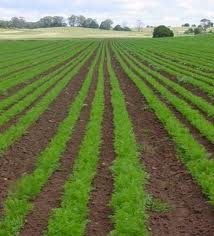My wonderful intern, Kimberly Guess has some great insight on how to go green on this wonderful Earth Day. Congratulations on becoming an official Registered Dietitian!!
Most Americans know very little about the origins of the food we eat and how food is actually produced. If you ask a child where a carrot comes from, he’ll probably say, “the grocery store.” We nourish our bodies with value meals from the comfort of the driver’s seat, make dinner by simply adding water, and refuel after a workout with something unrecognizable without its shiny, flashy package. Not to say that this is all wrong, but maybe it wouldn’t hurt to know where food truly comes from. Believe it or not, your food choices not only affect the health of your body, but also the health of our environment.
Most of us know that fruit, vegetables, and grains are grown in fields and orchards and things like that. In general, the animals we eat are raised by eating food and drinking water for a few years. What may surprise you is how much energy and resources it takes to produce a cow, chicken, or pig. It takes about 2,500 gallons of water to produce one pound of beef, as opposed to just 25 gallons of water to produce one serving of grains. Think about the hundreds or even thousands of pounds of food an animal would eat before it reaches your plate.

It also takes about 54 calories of fossil fuel to produce 1 protein calorie of beef, as opposed to 2 calories of fossil fuel to produce 1 protein calorie of soy. Much of the crops grown in the world are used up as animal feed. According to some estimates, animal production accounts for more than one-third of all fossil fuels used in the U.S.!
Here’s the part where I tell you to stop eating meat right? Not quite. Eating meat is a personal decision. While focusing on more of a plant-based diet may be good for your health and the environment, by cutting out meat for just one meal per week, you could save more than 15 gallons of gasoline per year!
You can also eat better for the environment by choosing foods that are minimally processed, use less packaging, and are produced locally. Highly processed foods use up an absurd amount of energy in production, packaging, and refrigeration, and transportation. Most of the packaging (which is most likely recyclable) on foods is thrown away. Food in the U.S. travels an average of 1,500 miles before it is consumed. By shopping at farmer’s markets, co-ops, and grocery stores that supply local foods, you can purchase extremely fresh foods that may be higher in nutrients and have likely traveled less than 100 miles. Still not convinced? A 2008 study by Pimentel et al. in Human Ecology “strongly argues that the consumer is in the strongest position to contribute to a reduction in energy use.” This study suggests that a healthier diet and a return to traditional farming could help reduce energy consumption in the U.S. food system by 50 percent!
Climate change is real, and continues to occur at an alarming rate. The good news is that each one of us can do our part with something as simple as the food choices we make. Imagine the power we have to protect our planet by using less resources, recycling more, driving less, and making conscious decisions about food. For more information about what you can do to reduce climate change, go to http://epa.gov/climatechange/wycd/index.html
by: Kimberly Guess, RD
Other recommended reading:
- Energy to Recycle Glass Bottles vs. Aluminmum Cans vs. Plastic http://greenliving.nationalgeographic.com/energy-recycle-glass-bottles-vs-aluminum-cans-vs-plastic-2376.html
- 8 Ways Vegetarian is Good for the Planet
http://earth911.com/news/2012/04/09/how-vegan-and-vegetarian-diets-help-the-environment/
- Earth Day Fitness Guide: 10 Ways to Save the Planet and Improve Your Health http://www.nola.com/health/index.ssf/2012/04/earth_day_fitness_guide_10_way.html